Parque Natural de Urkiola · Ayuntamiento de Abadiño
Situación
Menú principal
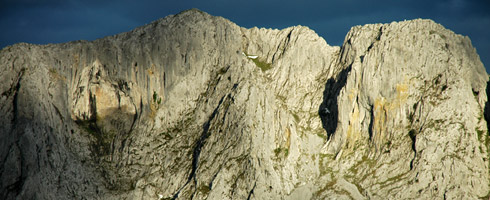
The crag is the most characteristic feature of the Urkiola Natural Park landscape. A long chain of limestone escarpments run from the Arangio range to Aramotz: Anboto, Alluitz, Aitz-Txiki, Untzillatx, Mugarra. The relief of the rocks has taken on a series of strange shapes: Cracks, cliffs, shelves, gulleys, etc are formed due to the erosion of the limestone. This variety means that there is a very high diversity of plant species and turn this environment into the most interesting place in the Park in terms of the flora to be found there.
Various different plant communities can be found there. The cracks in the walls, for example, are home to various ferns (maidenhead spleenwort, fountain spleenwort, fragile fern) and some flowering plants (saxifrage, sweetleaf, everlasting flower, Draba dedeana). The shelves are home to the blue moor grass, Globularia nudicaulis and Rosa pendulina. Some large leaf plants, such as yellow monkshood, Welsh poppy and the black hellebore.
Some trees and bushes, including the yew tree, alpine buckthorn and the rock whitebeam, occasionally root in cracks and holes. Many of the crag plants that are less common in the Urkiola mountains are much more abundant in the Pyrenees or in the Picos de Europa, such as the Alpine Aster and the Pyrenean Columbine.
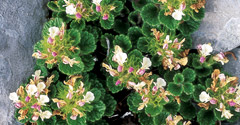
Small plant, 5-15 cm high, woody at the base, rather downy and with droopy stems. The leaves are on opposite sides of the stem and are round, the base is in a cradle and with a gently serrated edge. It flowers from May to July. The flowers are arranged in dense heads. They are white and purple at the tips. It is a plant that withstands the hard conditions on the crags, such as the lack of water, soil and extreme temperatures.
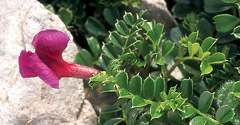
Small stolonipheral plant, 5-30 cm high. The leaves have small round leaflets and end in a tendril. The flowers are 2 cm long, single and bright violet-purple in colour. It flowers from May to July and the fruit is a long black legumbre. Thanks to the stolons that attach the plant to the floor, it can live in the gulleys that are in constant movement.
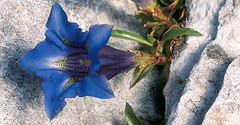
5-20 cm high plant, with shiny green leaves that are lanceolate in shape. Most of the leaves grow at the base of the stem. The flowers are large and are trumpet in shape. They are deep blue in colour with green hues inside. It flowers from May to August. It is native to the western Pyrenees and Cantabrian mountains. It is only found near to the Anboto and Mugarra summits in the park.

Plant 10-30 cm high, with stems that are generally arranged in branches. It usually has 1 to 5 large bright blue or lilac flowers. The flowers have some long spolons behind. It flowers from May to July. It is native to the western Pyrenees and Cantabrian mountains. It is a rare species in the Park and is scattered along the steep cliffs of Aramotz, Untzillatx, Alluitz and Anboto.
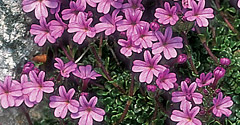
Small plant, 5-20 cm high, with numerous florid stems. The leaves are in the shape of a spatula, with the inside leaves growing in a rosette. It has small pink-purple flowers arranged at the end of the branches. It flowers from May to September. It grows in cracks on rocks and stones on the limestone crags, such as Ipizte, Alluitz, Aitz-Txiki and Mugarra.
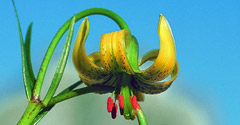
Bulb plant, 40-100 cm high, robust with numerous narrow, long leaves around the stem, bright green in colour. The flowers are large, hanging, bright yellow with black highlights, the petals are turned backwards. It flowers from May to July at the foot of cliffs, rocky walls and cracks. It is native to the western Pyrenees and Cantabrian mountains. It can be seen hanging from the Urrestei walls, the Alluitz channels, on Aitz-Txiki and on Eskuagatx.
2006 - 2007 © Anteiglesia de Abadiño Town Council - All rights reserved